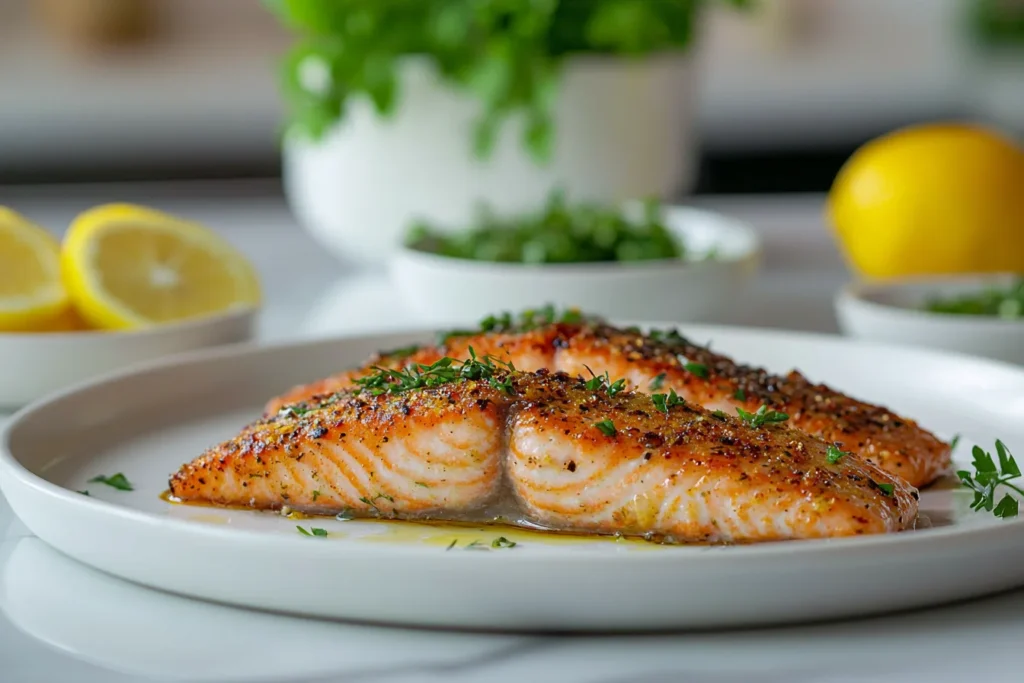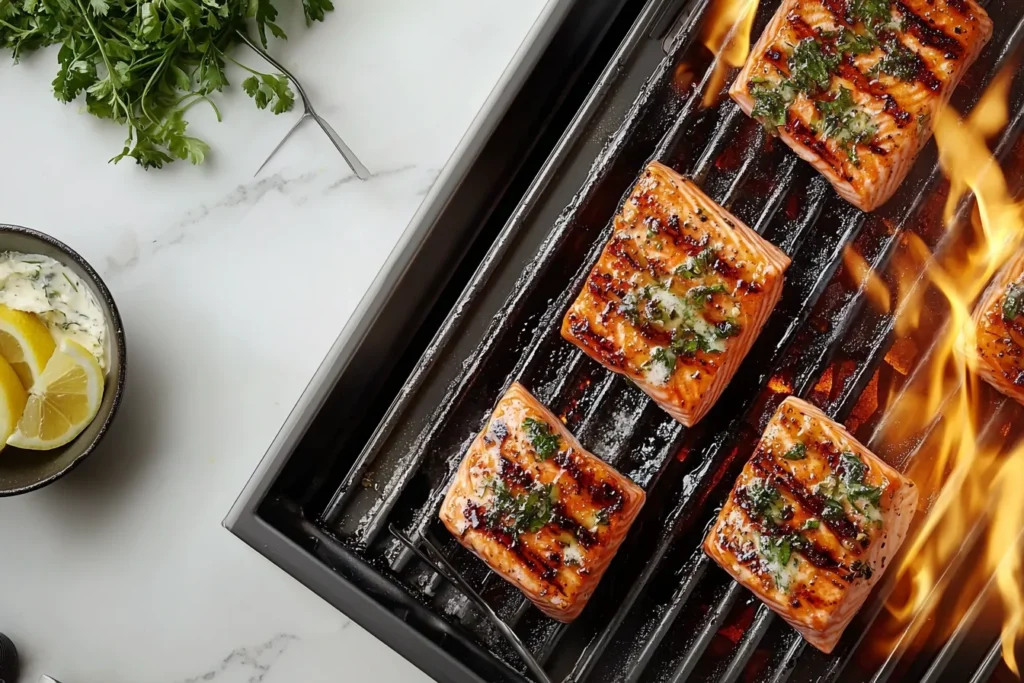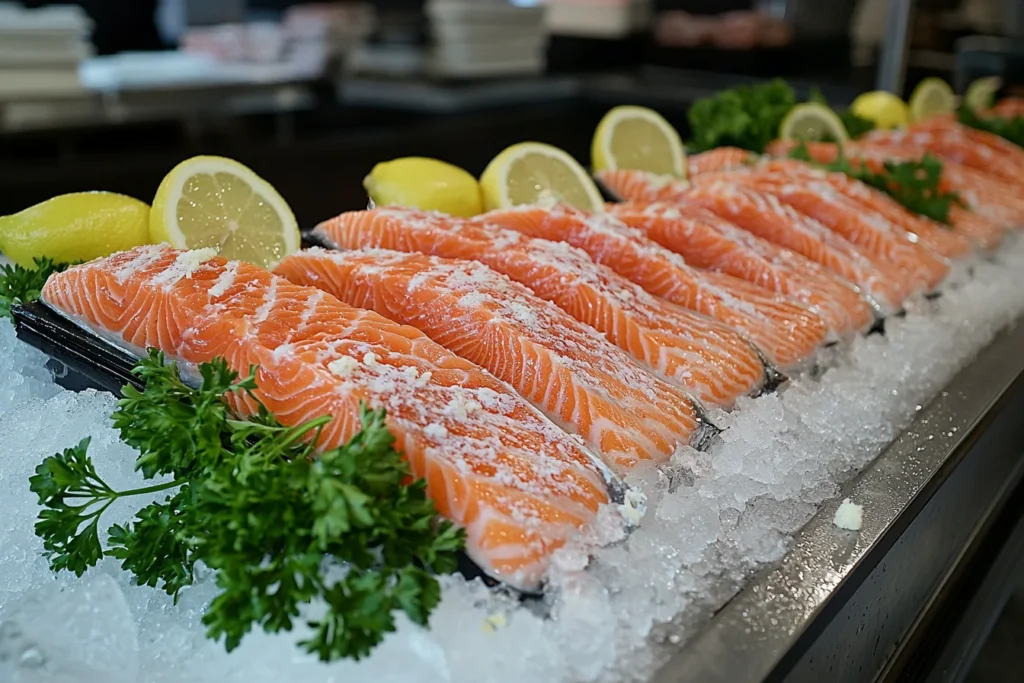Have you ever wondered, “Is king salmon different from salmon?” It’s a common question, especially when shopping for seafood or planning a special meal. The differences might surprise you, and understanding them can help you choose the perfect fish for any occasion.
King salmon is often called the “king” for a reason. It’s prized for its rich flavor, buttery texture, and nutritional benefits. Meanwhile, other types of salmon, like sockeye or coho, have their own unique characteristics. First, king salmon is larger and richer, making it a favorite for indulgent dishes. Next, learning about these differences adds excitement to your cooking adventures.
So, why does it matter? Knowing how king salmon stands out lets you make better choices in the kitchen. Keep reading to discover everything you need to know. You’re just a step away from understanding this tasty seafood!
Table of Contents
Understanding King Salmon: A Premium Variety
Rich Flavor and Nutritional Value
King salmon is often celebrated for its rich, buttery flavor and exceptional nutritional value.

Its texture is firm yet melts in your mouth, making it a favorite for special meals. In addition to being delicious, king salmon is packed with omega-3 fatty acids, which are great for heart and brain health. First, its higher fat content compared to other salmon types contributes to its luxurious taste. Next, the vibrant orange-red hue of its flesh is another characteristic that sets it apart.
Nutritionally, king salmon is a powerhouse. It is loaded with protein, vitamins D and B12, and essential minerals like selenium. These nutrients make it a healthy and satisfying choice for meals. Whether grilled, baked, or pan-seared, it delivers exceptional flavor every time. Try incorporating king salmon into your meals by exploring this king salmon recipe for a delicious experience.
Unique Habitats and Lifecycle
King salmon, also known as Chinook salmon, has a fascinating lifecycle and thrives in unique habitats. Native to the Pacific Ocean, these fish are often found in both coastal and inland waterways. Their lifecycle involves migrating from freshwater streams, where they hatch, to the ocean, where they mature. First, they spend years growing in nutrient-rich waters before returning upstream to spawn.
This migration is key to their development, influencing their taste and texture. The long journey builds their muscle, making their meat firm yet tender. Next, the varied habitats they occupy contribute to their unique flavor profiles, which can differ slightly based on their environment. King salmon’s journey through these ecosystems adds a layer of richness that many food enthusiasts love. If you’re curious about how these differences impact flavor, king salmon is definitely worth trying.
How King Salmon Differs from Other Salmon Types
Size and Appearance Comparison
King salmon stands out from other salmon species due to its impressive size and striking appearance. It is the largest of all salmon types, often reaching weights of up to 50 pounds. First, its size alone makes it a showstopper on any dining table. The thick fillets offer a substantial, satisfying meal, unlike smaller salmon varieties. Next, its flesh has a vibrant orange-red hue, indicating its high-fat content and rich flavor.
Other salmon species, like sockeye or coho, are smaller and leaner, with variations in color and texture. Sockeye is known for its deep red flesh and firmer texture, while coho has a milder flavor and lighter color. These differences are not just visual; they impact cooking methods and taste. Learn more about Chinook salmon and its distinct features from NOAA’s dedicated Chinook Salmon resource. King salmon’s larger size and fat content make it ideal for grilling or roasting, delivering a moist and flavorful dish every time.
Taste Profiles Across Salmon Species
The taste of king salmon is rich, buttery, and unforgettable, setting it apart from other salmon varieties. Its high-fat content creates a luxurious mouthfeel, perfect for indulgent recipes. Sockeye, in contrast, has a bold and slightly nutty flavor, making it a favorite for those who enjoy robust tastes. Coho, often called “silver salmon,” offers a milder and more delicate flavor that works well in versatile dishes.
King salmon’s unique taste comes from its high oil content and varied diet, which includes krill and small fish. This gives it a richer and more complex flavor compared to other salmon types. Next, its tender texture makes it ideal for both simple preparations and gourmet dishes. Trying different salmon varieties allows you to appreciate their distinct characteristics, but king salmon remains the top choice for a truly indulgent meal.
Cooking with King Salmon vs. Other Salmon
Ideal Cooking Methods for King Salmon
Cooking king salmon is a delightful experience, thanks to its rich, firm texture and high-fat content.

Grilling is a popular choice because it locks in the natural oils while adding a smoky, charred flavor. First, ensure you use medium heat to avoid overcooking. Next, pan-searing offers a quick and simple method that creates a crisp crust while keeping the inside moist.
Baking is another excellent method, especially when paired with herbs, lemon, and butter. The fat in king salmon prevents it from drying out, making it forgiving even for beginners. To find more inspiration, check out the tastiest way to cook salmon and elevate your cooking game with this premium fish. Also, poaching is a gentle option that preserves its delicate texture and enhances flavor. Each method brings out unique flavors, so feel free to experiment with your favorites at home.
No matter which method you choose, king salmon always delivers a satisfying, restaurant-quality meal you can enjoy.
Popular Recipes for Different Salmon Varieties
Different types of salmon inspire a variety of recipes to suit their unique qualities and versatility. King salmon’s richness makes it ideal for dishes like cedar-plank grilling or lemon-butter baked fillets. Coho salmon, on the other hand, shines in recipes like citrus-marinated salads or tacos due to its lighter flavor profile and adaptability.
Next, sockeye salmon works well in hearty dishes like salmon burgers, smoked spreads, or flavorful chowders. For those seeking quick meals or snacks, pink salmon is perfect for salmon cakes, croquettes, or pasta dishes. Additionally, keta salmon is a great choice for stews, curries, or casseroles, thanks to its firmer texture.
Choosing the right recipe enhances the natural flavor of each type, allowing you to enjoy their differences and maximize their potential. Explore more ideas for what goes well with salmon by visiting this guide on what goes with king salmon. Whether you prefer bold or mild flavors, there’s always a perfect recipe for every salmon lover to savor.
Health Benefits of King Salmon Versus Other Salmon
Omega-3 Content and Nutritional Highlights
King salmon is celebrated for its exceptional omega-3 content, making it a top choice for heart health. These healthy fats support brain function, reduce inflammation, and promote glowing skin. First, it offers a higher concentration of omega-3s compared to other varieties, such as coho or sockeye. Next, it provides essential nutrients like vitamin D, selenium, and high-quality protein, all vital for building strong muscles and boosting immunity.
Additionally, its low mercury levels make it a safer option for regular consumption. Whether you grill, bake, or sear it, the nutritional benefits remain intact. This premium seafood is ideal for anyone seeking nutrient-packed meals that are as delicious as they are healthful. Including it in your diet can contribute to a balanced, satisfying, and wholesome lifestyle, while enhancing your body’s overall wellness.
Why King Salmon Is a Healthy Choice
King salmon is an excellent choice for anyone looking to improve their overall health. First, its rich fat content not only enhances flavor but also provides long-lasting energy for your daily needs. Additionally, the high-quality protein in king salmon aids muscle repair, making it ideal for active lifestyles and balanced diets. Compared to other salmon varieties, king salmon contains higher levels of antioxidants, which help fight harmful free radicals in the body.
Next, it’s versatile in the kitchen, allowing you to create meals that are both nutritious and enjoyable. Its rich nutritional profile includes essential vitamins, minerals, and omega-3s, supporting heart health and brain function. Adding king salmon to your meals can bring variety and elevate your overall health in a flavorful, satisfying way. It’s an ideal addition to a diet focused on wellness and delicious, balanced eating.
Market Availability and Cost of King Salmon
Seasonal Variations and Availability
King salmon availability changes throughout the year, making it a sought-after delicacy during peak seasons.

First, the fishing season for wild-caught varieties typically spans from late spring to early fall, depending on the region. This limited window makes fresh options highly prized and ensures top quality. Additionally, farmed alternatives provide a consistent, year-round supply.
Seasonal availability influences both pricing and flavor, with wild-caught fish offering a distinct richness during its prime months. Next, regional differences, such as Alaska’s abundant fisheries, significantly impact availability. While fresh fish is often the top choice, frozen options help ensure this premium product remains accessible throughout the year. Understanding seasonal patterns allows you to find the best quality and timing. Planning your purchase during peak seasons not only maximizes flavor but also offers the best value for your investment. Learn more about how king salmon should be cooked to make the most of this seasonal delicacy.
Factors Affecting Pricing
The cost of king salmon depends on several factors, including its origin and market demand. First, wild-caught varieties are typically more expensive than farmed options due to their limited availability. Additionally, the location of the catch affects pricing, with Alaskan sources often commanding a premium because of their pristine environment and exceptional quality. Transportation costs and whether the fish is sold fresh or frozen also influence the overall price.
Next, seasonal demand, especially during holidays or special occasions, can push costs even higher. Despite its premium price, this fish delivers unmatched flavor and nutritional benefits, making it a worthwhile splurge for many. For budget-friendly options, consider purchasing during peak seasons or choosing frozen alternatives for consistent affordability. Understanding these factors can help you make smart decisions and enjoy the incredible taste of king salmon without straining your budget.
Tips for Choosing Between King Salmon and Other Salmon
When to Choose King Salmon
King salmon is the ideal choice when you want a premium, rich-tasting fish that elevates any meal. Its high-fat content provides a luxurious texture and intense flavor, making it perfect for special occasions or gourmet recipes. First, this variety works wonderfully for grilling, baking, or pan-searing, as its firm flesh holds up well during cooking. Its natural richness also pairs beautifully with bold seasonings, creamy sauces, and hearty sides.
For those prioritizing nutritional value, this fish shines with its exceptional omega-3 content, promoting heart health and overall wellness. It’s also a standout when you want to impress guests with a stunning, flavorful dish. The vibrant color and tender texture make it an eye-catching centerpiece for any table. Choose king salmon when flavor, quality, and versatility are essential for creating a memorable dining experience.
Best Uses for Other Salmon Varieties
Other salmon varieties, such as sockeye, coho, and pink salmon, offer their own unique benefits and versatility in the kitchen. First, sockeye salmon, with its bold flavor and deep red color, is excellent for grilling and roasting. Coho salmon is milder and works well in lighter recipes like salads, pastas, or fish tacos. Pink salmon, though more delicate, is budget-friendly and ideal for canning or creating spreads and dips.
Additionally, these varieties often have lower fat content than king salmon, making them a lighter alternative for health-conscious meals. Next, farmed Atlantic salmon is widely available and great for everyday dishes due to its mild flavor and affordability. By understanding the strengths of each variety, you can select the perfect salmon for any occasion. Incorporating different types into your cooking adds variety and ensures a delightful meal every time.
Frequently Asked Questions (FAQs)
Is king salmon better than regular salmon?
King salmon is often considered better than regular salmon due to its rich flavor and tender texture. Its high-fat content gives it a buttery taste, making it a favorite for special dishes. First, king salmon’s larger size and vibrant orange-red flesh make it visually stunning.
Next, its nutritional benefits, including omega-3 fatty acids, set it apart as a healthier choice. Other types of salmon, like sockeye or coho, offer their own unique flavors and uses. Ultimately, the best salmon depends on your taste and the dish you’re preparing. Try king salmon for a truly indulgent experience!
Are king fish and salmon the same?
King fish and salmon are not the same, as they come from different species and regions. King salmon, also called Chinook salmon, is a type of salmon known for its rich flavor and high-fat content. On the other hand, king fish refers to a variety of species like yellowtail kingfish, often used in different cuisines.
First, the two fish differ in taste, texture, and culinary uses. While king salmon has a buttery, tender texture, king fish is leaner and firmer. Next, both have unique nutritional benefits, but they are distinct in flavor profiles and preparation methods.
Why is king salmon more expensive?
King salmon is more expensive due to its rarity, superior quality, and rich flavor. Wild king salmon is harvested in limited quantities during specific fishing seasons, which increases its value. Additionally, it is the largest and fattiest salmon species, offering a luxurious texture and taste that many seafood lovers seek.
First, the location of the catch, like pristine Alaskan waters, can drive up costs. Next, transportation and the method of processing, whether fresh or frozen, also affect the price. Its unmatched nutritional value and gourmet appeal make it a premium choice worth the investment.
What type of salmon is king salmon?
King salmon, also known as Chinook salmon, is the largest and richest salmon species. It is native to the Pacific Ocean and is prized for its buttery flavor, high-fat content, and tender texture. Its vibrant orange-red flesh makes it stand out from other types of salmon.
First, king salmon is often caught in cold, pristine waters, like those in Alaska, which enhances its quality. Next, its high omega-3 levels and essential nutrients make it a popular choice for health-conscious individuals. Whether baked, grilled, or seared, king salmon delivers an indulgent and delicious meal every time.
Bringing It All Together: Choosing the Right Salmon for You
Understanding the differences between king salmon and other salmon varieties can help you make better choices. King salmon stands out with its rich flavor, firm texture, and high-fat content. First, it’s perfect for special meals or recipes that call for a luxurious taste. Other types, like sockeye or coho, offer their own unique qualities, making them great for different occasions and dishes.
Next, consider your preferences and needs when deciding. If nutrition is your priority, king salmon’s omega-3 content and health benefits make it an excellent option. Meanwhile, more affordable choices, like pink or Atlantic salmon, work well for everyday cooking or quick meals. Also, keep in mind availability and budget to find what fits your plans best.
Now it’s time to try these ideas and enjoy salmon your way. Share your favorite salmon recipes or tips in the comments below! Your perfect meal is just a dish away.

